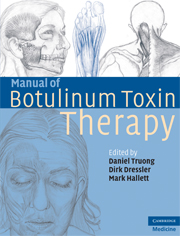Book contents
- Frontmatter
- Contents
- List of contributors
- Foreword – Alan B. Scott
- Preface
- 1 The pretherapeutic history of botulinum toxin
- 2 Botulinum toxin: history of clinical development
- 3 Pharmacology of botulinum toxin drugs
- 4 Immunological properties of botulinum toxins
- 5 Treatment of cervical dystonia
- 6 Treatment of hemifacial spasm
- 7 Treatment of blepharospasm
- 8 Treatment of oromandibular dystonia
- 9 Treatment of focal hand dystonia
- 10 Botulinum toxin applications in ophthalmology
- 11 Botulinum toxin therapy of laryngeal muscle hyperactivity syndromes
- 12 The use of botulinum toxin in otorhinolaryngology
- 13 Spasticity
- 14 The use of botulinum toxin in spastic infantile cerebral palsy
- 15 Hyperhidrosis
- 16 Cosmetic uses of botulinum toxins
- 17 Botulinum toxin in the gastrointestinal tract
- 18 Botulinum toxin in urological disorders
- 19 Use of botulinum toxin in musculoskeletal pain and arthritis
- 20 The use of botulinum toxin in the management of headache disorders
- 21 Treatment of plantar fasciitis with botulinum toxin
- 22 Treatment of stiff-person syndrome with botulinum toxin
- 23 Botulinum toxin in tic disorders and essential hand and head tremor
- 24 Developing the next generation of botulinum toxin drugs
- Index
- References
15 - Hyperhidrosis
Published online by Cambridge University Press: 28 July 2009
- Frontmatter
- Contents
- List of contributors
- Foreword – Alan B. Scott
- Preface
- 1 The pretherapeutic history of botulinum toxin
- 2 Botulinum toxin: history of clinical development
- 3 Pharmacology of botulinum toxin drugs
- 4 Immunological properties of botulinum toxins
- 5 Treatment of cervical dystonia
- 6 Treatment of hemifacial spasm
- 7 Treatment of blepharospasm
- 8 Treatment of oromandibular dystonia
- 9 Treatment of focal hand dystonia
- 10 Botulinum toxin applications in ophthalmology
- 11 Botulinum toxin therapy of laryngeal muscle hyperactivity syndromes
- 12 The use of botulinum toxin in otorhinolaryngology
- 13 Spasticity
- 14 The use of botulinum toxin in spastic infantile cerebral palsy
- 15 Hyperhidrosis
- 16 Cosmetic uses of botulinum toxins
- 17 Botulinum toxin in the gastrointestinal tract
- 18 Botulinum toxin in urological disorders
- 19 Use of botulinum toxin in musculoskeletal pain and arthritis
- 20 The use of botulinum toxin in the management of headache disorders
- 21 Treatment of plantar fasciitis with botulinum toxin
- 22 Treatment of stiff-person syndrome with botulinum toxin
- 23 Botulinum toxin in tic disorders and essential hand and head tremor
- 24 Developing the next generation of botulinum toxin drugs
- Index
- References
Summary
Definition, prevalence, and diagnosis
Hyperhidrosis may generally be defined as excessive sweating or sweating beyond physiological needs. It may be divided into generalized, regional, and localized/focal types and, according to whether the cause is known or not, into primary or idiopathic forms. Secondary hyperhidrosis can be induced by a wealth of infectious, endocrine, metabolic, cardiovascular, neurological, psychiatric, and malignant conditions, and can also be caused by certain drugs and poisoning. The prevalence of hyperhidrosis in the US population has been calculated at 2.8% (Strutton et al., 2004). Of those, primary axillary hyperhidrosis appears to be the most frequent type, severely affecting 0.5%.
According to a consensus statement, primary focal hyperhidrosis (PFH) can be diagnosed as explained inTable 15.1 (Hornberger et al., 2004). It usually starts in childhood or adolescence and mainly involves the armpits, palms, soles, and craniofacial region, either alone or in various combinations. There are well-known, emotional triggers of sweating episodes, but the exact pathogenesis of the overstimulation of eccrine sweat glands is still poorly understood apart from a clear genetic background.
As measured by standardized questionnaires, PFH negatively affects many aspects of daily life to a significant extent, including emotional status, personal hygiene, work and productivity, leisure activities and self-esteem (Hamm et al.,2006). The so-called hyperhidrosis disease severity scale (HDSS) (Table 15.2), a single-item question allowing four gradations of the tolerability of sweating and its interference with daily activities, offers a simple and useful way to estimate the impairment of quality of life (Lowe et al., 2007).
Information
- Type
- Chapter
- Information
- Manual of Botulinum Toxin Therapy , pp. 123 - 132Publisher: Cambridge University PressPrint publication year: 2009
References
Accessibility standard: Unknown
- 2
- Cited by
